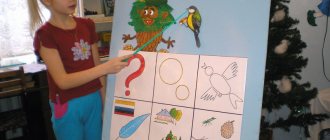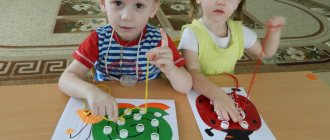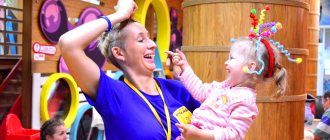Having passed the 3-year mark, children continue to develop rapidly. This progress is especially noticeable in their speech: their vocabulary grows, pronunciation, intonation, expressiveness improve, verbal structures become more complex, monologues become more coherent and consistent. At this stage, it is necessary to properly help the kids in their progress. To do this, it is important to know the main characteristics of the speech development of your children at the age of 4–5 years and understand what is important to work on now.
Age features
After 4 years, children are able to fluently use adverbs, adjectives, and prepositions, although the purity of pronunciation may still suffer due to difficulties with sonorants or sibilants (however, by the end of the fifth year, all sounds normally fall into place). A huge role in this belongs to parents, their ability to create a correct, active speech environment around the child and a favorable environment in the family.
The speech of children of primary preschool age is characterized by the following features:
- children can name the names, patronymics, surnames of all members of their family, and residential address;
- speak 3000–4000 words and actively use them;
- know how to navigate the time of day and the space around them;
- know the names and sequence of seasons;
- know all the basic geometric shapes, counting to five;
- use polite words;
- can identify their well-being and mood;
- know how to fully answer questions and ask them to the interlocutor;
- make a fairly detailed retelling, compose stories on a given topic, come up with the end of the designated story;
- can describe objects, identify an object only by description;
- build phrases of 6–8 words;
- use the imperative mood, plural;
- use synonyms and antonyms,
- use adjectives, adverbs, prepositions correctly;
- coordinate words in a sentence by gender, number, case;
- determine the distinctive features of objects;
- know different professions and their essence;
- can easily retell what they heard and saw;
- They know poems, tongue twisters, and funny nursery rhymes by heart.
At this age, do not put pressure on your child, forcing him to speak correctly and clearly - you will achieve the opposite effect. It is better to make comments in a soft form, affectionately, and friendly. Then the child will probably correct his mistakes very quickly.
What will we develop?
For children 4–5 years old, several aspects of speech development are important, which directly depend on the level of their general development and condition, as well as the speech skills they have achieved.
- Active dictionary.
Now, in addition to nouns and verbs, the speech of preschoolers is distinguished by the presence of adverbs with signs of time and space (soon, now, about, around). The concept of stages of generalization (mouse - rodent - animal) appears. Children know animals, their babies, parts of objects (a car wheel, a cabinet shelf, a chair leg).
Expanding your vocabulary at this age is the main rule for mastering coherent speech.
- The grammatical structure of speech.
Children of this age are actively engaged in word formation. They begin to use suffixes that designate a person by his profession. Now the child forms word forms in a similar pattern, using the same grammatical features. Sometimes it may turn out incorrectly: it hurts - more painful, louder - louder. In the speech of children, there are fewer and fewer errors associated with the inflection of nouns and verbs. But if a mistake is made, after a hint from an adult, the child quickly learns the correct option: floor - floors, lake - “lakes” - lakes.
Mastering the grammatical construction of sentences will help children speak correctly, avoiding speech errors.
- Coherent speech.
After 4 years, children develop contextual speech in addition to situational speech. Inconsistent presentation of events and retelling with the help of questions or prompts from adults are also possible. By the age of 5, without additional help, a child can compose a coherent retelling of several dozen sentences, and among them there are already complex and complex constructions. At this age, the internal, planning function of speech is formed - it becomes a means of planning and regulating the child’s internal behavior.
From this time on, the speech gradually turns into a full-fledged story. In addition, the child increasingly uses the communicative function of speech - uses it for a variety of communication with others. He can ask again, object, clarify, and answer questions with reason.
Mastering coherent speech is an important factor in the success of a child’s further education.
- Speech (phonemic) hearing.
Children of this age group distinguish sounds of different articulations (for example, [a] and [r]), and note pronunciation errors not only in those around them, but also in themselves. Change intonation and timbre of voice during expressive retelling. They can distinguish vowels from consonants, hard from soft, hissing from whistling. They are able not only to determine whether there is a specific sound in a word, but also where exactly it is located (at the beginning, middle, end of the word).
The development of phonemic awareness allows you to pronounce words correctly, and then reproduce them in writing just as correctly.
- Pronunciation.
Normally, by the end of the 5th year, all inaccuracies and difficulties in sound production should disappear in a preschooler. Perhaps the child will pronounce middle sounds between [s] and [sh], [z] and [z], if he has recently mastered them. Sometimes children at this age do not pronounce [r]. At 5 years old, this problem already requires correction by a speech therapist.
So, a five-year-old child should speak expressively, coherently, using a rich vocabulary and a variety of syntactic structures, with virtually no speech errors, pronouncing all sounds clearly. It is important to work on this by involving the child in various linguistic games.
With the help of family
Growing up in a family, a child, first of all, adopts the experience of communicating with relatives: their vocabulary, ways of constructing sentences and expressing thoughts, intonation. Therefore, the speech development of children always depends on the environment in which they find themselves. How active and correct she is in terms of speech makes her psychologically comfortable.
The following tips will help you avoid mistakes.
- Do not imitate your baby's speech if it is incorrect: do not lisp, do not distort words or sounds.
- Always speak clearly and correctly, use the right emotions and intonations, the right tempo and strength of voice.
- When communicating with a child, try to exclude difficult to pronounce words, complex or incomprehensible phrases and expressions from your speech. It is important to explain unfamiliar words found in the work to a preschooler at a level accessible to him, reinforce them with examples, and try them out in practice.
- When asking a child about something, ask clear, specific questions, give them time to understand them, and don’t push them with an answer.
- Don’t imitate or get irritated if your baby makes a mistake: correct it calmly, gently.
- Read more poetry - it helps to master the rhythm of speech;
- Try to avoid frequent quarrels, scandals, cruel punishments, threats, and blackmail. All this not only inhibits the development of speech, but can lead to more serious consequences: stuttering, isolation, embitterment of the child, the appearance of complexes and phobias.
Role of parents
You should not assume that classes with a speech therapist alone will help the child completely solve the problem - parents should take a direct part in this. The child spends most of his time at home, so training should be carried out there.
Speech therapists advise parents to adhere to the following rules.
- Do not scold the baby for mistakes he has made in pronouncing sounds, but correct them.
- Encourage the child for his efforts and success, listen carefully to what he says about classes with a speech therapist, and show sincere interest.
- Ensure that the speech of family members is literate and correct.
- Before showing this or that exercise to a preschooler, you should practice in front of the mirror, check that everything is working out clearly and correctly.
- Ensure that children complete the speech therapist’s homework.
- Strives to ensure that every task is completed to the end, correctly, and diligently.
- Conduct classes daily - they can be small, but mandatory, they should become a good habit.
Specialist speech pathologists advise creating an atmosphere of correct speech for the child: reading him poems, fairy tales, singing songs more often, discussing any natural phenomena with the child, but it is better to keep TV watching to a minimum.
We teach in the game
After analyzing the above norms, parents can understand which areas of their child’s speech need to be developed first: those with which there are problems. To correct each individual area, you can select appropriate games for speech development. First of all, to expand your vocabulary. Here are some examples of such games.
- The adult names the object, and the child must put this word in the plural (wall - walls). In the course of such a game, you can also touch on polysemy (for example, a child, a chair or a seat can have a back, and a mug in the plural, only with a different emphasis - these are both geometric figures and sections for creative activities). At the same time, the child’s attention is promptly focused on the fact that not all words “multiply” equally (lion - lions, mouth - mouths). This develops the skill of using the plural and expands your vocabulary.
- You can introduce your child to antonyms by offering to select opposite meanings for words (soft - hard, clean - dirty). At the same time, let him select words with new meanings (white snow - black night), and then replace them with pronouns (he is white, she is black). This way the preschooler will practice agreeing words and using pronouns.
- After reading a story or poem, you can invite your child to come up with his own ending. It also develops thinking, imagination and coherent speech.
- Playing with a ball allows you to develop various skills: enrich your vocabulary, master synonyms, antonyms, recognize objects by description, form new forms of words. For example, a child is thrown a ball, naming the object, and he returns the ball, calling the object affectionately. Or in response to a word it selects the opposite meaning. Or names an object, having heard its signs, names the color of the specified object. Parents' imagination can suggest other options for such games.
- Animate and inanimate objects. The concept of them can be easily reinforced by playing with cards: the child must put animate objects in one group, inanimate ones in another, helping himself with questions: “This is a pear. She is alive? No. This is a cow. She is alive? Yes".
- Using a similar exercise, you can introduce your baby to relative adjectives. One group of cards will contain objects, the other will contain the materials from which they are made. The child’s task is to correlate the two pictures, saying: the ball is made of rubber. It's rubber. The pencil is made of wood. It is wooden.
In order for a preschooler’s speech to become more expressive, offer him such a game (several children or a family should play). The child, on the instructions of the adult, must demonstrate to the other players different shades of a person’s mood (fun, surprise, sadness, anger, fatigue, despondency). In this case, the baby can use appropriate intonation, facial expressions, interjections (oh-oh, wow, wow, eh, ah, ah-ah). The rest of the players guess what exactly was shown.
Diagnosis of speech disorders
You can assess the level of speech development at home. To do this, the child is asked to name the names of animals, dishes and furniture, and natural phenomena. The preschooler is given simple instructions that require him to formulate questions for an adult.
The ability to construct word combinations is assessed using the following actions:
- plural formation;
- determining the number of objects (helps to understand how correctly the child coordinates nouns and numerals);
- formation of diminutive forms;
- compiling a small text based on the proposed image;
- completion of a statement begun by an adult.
To perform sound analysis, you are asked to reproduce syllables containing different vowels and consonants. The rhythm of the child’s speech is also checked.
Her Majesty Grammar
Mastering grammatical structure is very important for children of this age, since it allows them to avoid incorrect use of word forms. To practice this skill, there are many game tasks that children perform with interest.
- Where is the mistake? The child is shown a card and describes the object depicted on it, making logical errors. The kid must discover them (big elephant - yes, winged - no, heavy - yes, blue - no).
- It doesn't happen that way . The child is read sentences in which he must detect a discrepancy with reality (winter has come, and migratory birds have returned from the south). Then the baby must correct this mistake (birds fly in the spring).
- Which? The adult names the object, the preschooler must select several characteristic adjectives for it (the sun is round, hot, yellow, the grass is green, tall, thick).
- What is this? The adult describes the object, and the child must guess it. The second option is that the child is given a card with a picture of an object, and he must describe the picture so that others can guess what it is about.
- What happens? The adult names the attribute of the object, the child’s task is to select as many nouns with this attribute as possible. For example, tall - a house, a closet, a fence, a giraffe, a construction crane; blue can be the sky, the sea, cornflowers, mother's eyes, a parrot, etc.
- Confused. An adult reads a sentence with an obvious usage error. The child must find it and correct it (the picture is of Masha, the hare is catching a fox, the children went for a walk, Kolya likes to play, Dasha got dressed and went into the yard, etc.).
Don't miss anything
Noting the child’s mistakes, parents can choose other games, for example, those that help master the singular and plural forms of verbs, the imperative mood, present and past tense, practice the use of adverbs, prepositions, the ability to coordinate nouns with adjectives, verbs, etc.
If a child has problems pronouncing sounds, tongue twisters, articulation exercises (discussed here), and the development of fine motor skills (described in this article) will help. If a child cannot differentiate sounds or syllables in speech, games to develop phonemic awareness will help (see here - “Speech development in preschool children”).
The main thing is to remember: we develop a child’s speech not in order to show off to neighbors or “outdo” someone, but to help the child in further socialization, in learning, and in communicating with peers. Therefore, you should not chase after someone or prove something to someone. The task of parents is to help their child become successful in life, and not to break someone else's records.
Exercises for speech development of children aged 4-5 years
Most speech development exercises can be done at home. Parents should not ignore their child's questions and requests.
By receiving answers, preschoolers learn to describe objects and determine their characteristics, express emotions and build monologues.
Articulation gymnastics
The following exercises help improve the pronunciation of problematic sounds:
- "Eat some jam." The child should imagine that he ate the pie, and the sweet filling remained on his lips. Perform movements that allow you to eat the jam. The tongue slowly licks the upper and lower lips.
- "Shovel tongue." You need to imagine an instrument that needs to be placed on a stand, which is the lower lip. The tongue is pulled out and tried to be kept elevated as long as possible.
- "Tongue-needle." The organ is pulled out and twisted into a tube, holding it in this position for at least 10 seconds.
- "I am a horse." The child imagines himself as a horse that clicks its tongue and stomps its hoof. The order of the legs is changed.
Developmental classes last 5-10 minutes and are held in the morning and evening. Books with bright illustrations help increase a child’s interest in learning.
Finger games
The following exercises contribute to speech development:
- "Kitty." The palms are clenched into fists and placed on a flat surface. At the same time, extend your fingers, pressing them to the table. Actions are performed 4-5 times. After a while the task becomes more difficult. The child should straighten and clench his fingers alternately.
- “Treat the cat with milk.” The palms are folded into a ladle, making movements that imitate scooping milk.
- "Bunny." The index and middle fingers are folded so that they resemble bunny ears. The hands are clenched into fists, after which they imitate the running of an animal.
- "Dog". The hands are clasped and, extending the index and thumb, they run across the table.
It is recommended to combine finger exercises with learning poems. Fine motor skills training accelerates the development of the speech center of the brain. The child begins to easily remember and reproduce new information.
Logorhythmics
Studying poetry with children for speech development.
Logorhythmics is the reading of poems accompanied by a musical background and a set of movements, for example, using a ball. Exercises of this type have a positive effect on the formation of children's speech.
The parent shows an example of performing the actions, the child reproduces what he saw. Classes are held after naps every 2 days.
Equally important is watching cartoons to help you remember the alphabet, colors and numbers. You need to choose universal works with high quality sound and image.
Tongue twisters and sound production
Tongue twisters are phrases that have a storyline. Memorizing such sentences helps expand your vocabulary and improve pronunciation. Tongue twisters may contain the letters "l" and "r", hissing sounds, or combinations of these elements. With the correct selection of phrases, diction improves and literacy increases.









